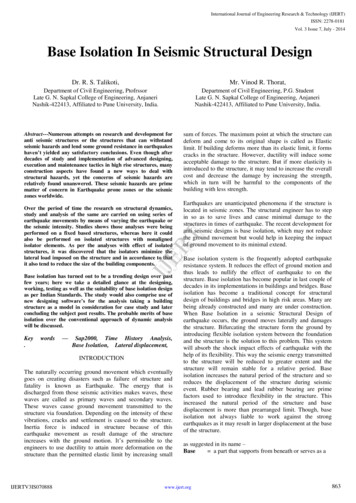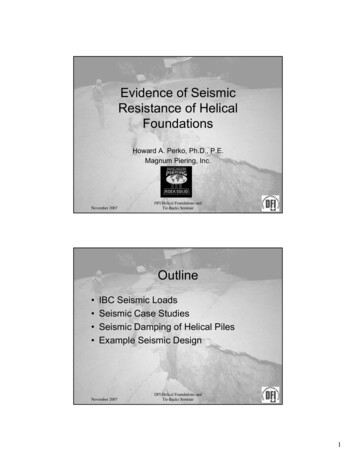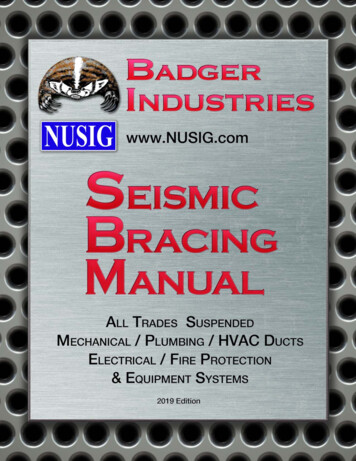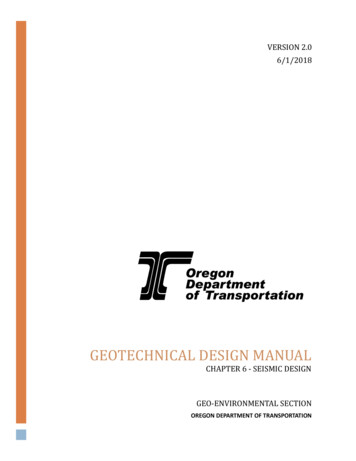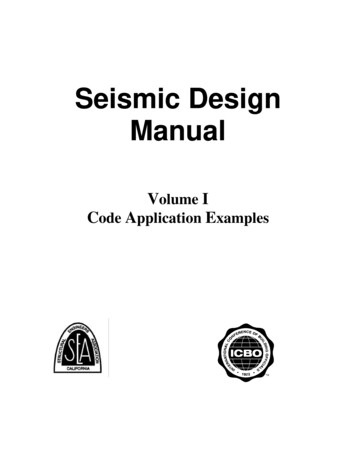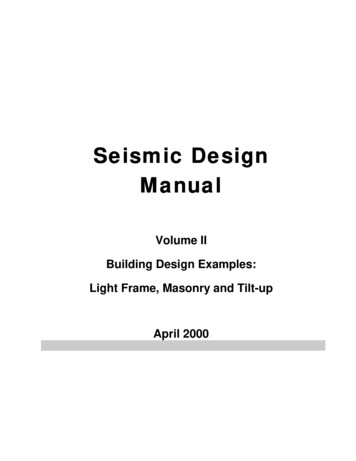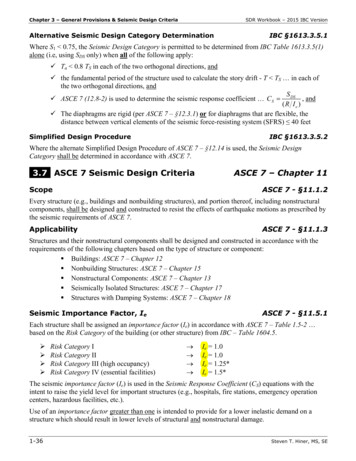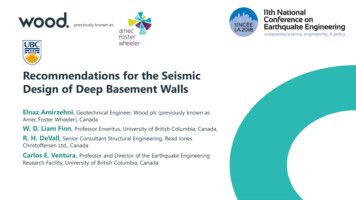
Transcription
previously known asRecommendations for the SeismicDesign of Deep Basement WallsElnaz Amirzehni, Geotechnical Engineer, Wood plc (previously known asAmec Foster Wheeler), CanadaW. D. Liam Finn, Professor Emeritus, University of British Columbia, Canada,R. H. DeVall, Senior Consultant Structural Engineering, Read JonesChristoffersen Ltd., CanadaCarlos E. Ventura, Professor and Director of the Earthquake EngineeringResearch Facility, University of British Columbia, Canada
Seismic Pressures on Basement Walls: Current Practice(Mononobe and Matsue, 1929 and Okabe, 1924) Coulomb (1776) theory: Mononobe-Okabe (M-O) theory: 0Amirzehni, Finn, DeVall, and Ventura (2018)Recommendations for the Seismic Design of Deep Basement Walls2
Project Motivation1. Recent changes in the National Building Code of Canada– NBCC 1995: 10% probability of exceedancein 50 years PGA 0.24g for Vancouver– NBCC 2005 and 2010:2% probability of exceedancein 50 yearsPGA 0.46g for Vancouver2. Stiff wall elements attract load– The M-O method was originally developed for gravitynon-yielding retaining walls with sufficient rigid bodydisplacements to mobilize the active wedge in thesoil.base figure from Budhu (2009)3. Basement walls have historically behaved well both statically and during earthquakesunder a wide range of earthquake shaking.– “ there have been no reports of damage to building basement walls as a result of seismicearth pressures in recent earthquakes ”Amirzehni, Finn, DeVall, and Ventura (2018)Recommendations for the Seismic Design of Deep Basement Walls3
Research Objectives SEABC set up a task force to review current seismic design procedures fordeep basement walls and the UBC was asked to carry out this research. The main purposes of this study are:– Capture the essential features of the seismic behavior of the basement wallsystems, and– Determine an appropriate fraction of PGA for Vancouver to be used in the M-Oanalysis to ensure a satisfactory performance in terms of moment and shearcapacity and drift ratio along the height of the wall. Recent centrifuge tests at UC-Berkeley confirm that the M-O pressurescalculated using 100% PGA are considerably higher than measured pressuresand a reduced seismic coefficient less than PGA can be used for the design.Amirzehni, Finn, DeVall, and Ventura (2018)Recommendations for the Seismic Design of Deep Basement Walls4
Computational Model of Basement Walls100% PGA70% PGA60% PGA50% PGAShear wave velocity (m/s)0 200 400 600 800Representative of non-deltaic Vancouver lithologyTillStiffer TillAmirzehni, Finn, DeVall, and Ventura (2018)Vs1 200 m/sγ 1950 kg/m3c 0 kPaφ 33v 0.28Vs1 400 m/sc 20 kPaφ 40v 0.28γ 1950 kg/m3Recommendations for the Seismic Design of Deep Basement Walls5
Computational Model of Basement Walls The actual construction sequence was modeled in stages to simulate the actualsequence of excavation. Interface elements were used to simulate interaction between the concrete basementstructure and surrounding soil. Appropriate boundary conditions were enforced at the computational modelboundaries. 14 crustal motions spectrally matched to NBCC2010 UHS of Vancouver were selected. Stress-strain response of soil was modeled usingMohr-Coulomb model with non-associated flowrule. Additional G/Gmax and damping ratios wereincorporated to account for stiffness reduction andcyclic energy dissipation during the elastic range ofthe response.Amirzehni, Finn, DeVall, and Ventura (2018)Recommendations for the Seismic Design of Deep Basement WallsG/Gmax 0.41D 8%G/Gmax 0.81D 3%6
Preliminary Results NBCC (2010) mandated PGA for Vancouver (0.46g)leads to very large seismic forces that makes theresulting basement structures very expensive. Our preliminary results suggest that safe basementwalls can be designed using the M-O method aspresently used in Vancouver, but with a horizontalacceleration of 50-60% NBCC (2010) PGA insteadof 100% PGA. Lew et al. (2010) and Sitar et al. (2012) reportedsimilar conclusion based on a number of detailedcentrifuge test studies.Amirzehni, Finn, DeVall, and Ventura (2018)Recommendations for the Seismic Design of Deep Basement Walls7
Sensitivity Analyses Goal : To further evaluate the recommended fraction of PGA Soil constitutive model– The results using Mohr-Coulomb with an additional modulus reduction factor andRayleigh damping were sensitive to the selection of G/Gmax and damping values.– More representative total stress UBCHYST model is used. This model replicates thebehaviour of real soil and reduces the essence of defining G/Gmax and Rayleighdamping with the simple Mohr-Coulomb model.– The result of the analyses using UBCHYST model confirms that the performance ofthe basement walls designed for NBCC (2010) 50% to 60% PGA seem adequate. Effect of ground motion selection and scaling Effect of subsurface soil condition Effect of wall geometryAmirzehni, Finn, DeVall, and Ventura (2018)Recommendations for the Seismic Design of Deep Basement Walls8
Effect of Selection and Modification of Ground Motion Time Histories Ground motion scaling methods:– Spectral matching: Popular in engineering practice. Meets the target spectrum requirements adequately. Reduces the variance of the structural responses and provides a platform toestimate the mean response with fewer numbers of analyses.– Linear scaling: Gets reliable estimate of the mean response of a structure and an adequatemeasurement of its variation about the mean.-At a single period PGA scaling Sa(T1) scalingAmirzehni, Finn, DeVall, and Ventura (2018)-Over the period range MSE scaling SIa scaling ASCE scalingRecommendations for the Seismic Design of Deep Basement Walls9
Ground Motions Scaling and Matching TechniquesAmirzehni, Finn, DeVall, and Ventura (2018)Recommendations for the Seismic Design of Deep Basement Walls10
Effect of different methods of Scaling/Matching Earthquake MotionsPerformance Criteria:450% PGADrift (%)31.7% acceptance criteria210Scaled at PGA Scaled at T Ts SIa 0.2T-1.5TMSE 0.2T-1.5T ASCE 0.2T-1.5T Spectral Matching460% PGADrift (%)31.7% acceptance criteria210Scaled at PGA Scaled at T Ts SIa 0.2T-1.5TAmirzehni, Finn, DeVall, and Ventura (2018)MSE 0.2T-1.5T ASCE 0.2T-1.5T Spectral MatchingRecommendations for the Seismic Design of Deep Basement Walls- ASCE Task Committeeon Design of BlastResistant Buildings inPetrochemical Facilities- Separate calculationsconducted usingstandard procedure forcalculating curvaturedemand in reinforcedconcrete the performancecriterion of 1.7% isadopted for drift ratio.11
Dominant Earthquake Mechanism in BC, Canada Deep subcrustal (M6.5-7.5; Distance: 30-150 km; Site Class C) Cascadia subduction (M8.0-9.0; Distance: 30-150 km; Site Class C) Near-fault pulse-like (M6.5-7.5; Distance: 0-20 km; Site Class C; Pulse)450% PGADrift (%)31.7% acceptance criteria210Shallow crustalDeep subcrustalCascadia subduction Near-fault pulse-like460% PGADrift (%)31.7% acceptance criteria210Shallow crustalAmirzehni, Finn, DeVall, and Ventura (2018)Deep subcrustalCascadia subduction Near-fault pulse-likeRecommendations for the Seismic Design of Deep Basement Walls12
Effect of local site conditionAmirzehni, Finn, DeVall, and Ventura (2018)Recommendations for the Seismic Design of Deep Basement Walls13
Effect of Basement Wall Geometry– 4-level basement wall with 5.0 m top storey (H 13.1 m)– 6-level basement wall (H 17.1 m)Amirzehni, Finn, DeVall, and Ventura (2018)Recommendations for the Seismic Design of Deep Basement Walls14
Summary of More Than 600 Nonlinear Dynamic Analyses450% PGADrift (%)321012124Drift (%)3210The level of variability of theresponse in the formof standard1.7% acceptancecriteriaThe presence of a relatively soft soildeviation of the resultant driftAdoptingmorerepresentativeconstitutiveEffect ofInadditionthe14 layercrustalgroundthewallbasement wallratios arereduced tosignificantlyas underneathmodel for14simulatingnonlinearstress–straingeometry contrastin form movesfrom:3 4 5 response6 7 8 9of1011 soil12 1314 15 16does17 18not19 2021 2223 24 25 26 ear-faultpulse-likeCasebetweensoil layers, affect the Linear scaling the recordsatNo.considerableeffect onandthe seismicnumberrecordswere selectedscaledtoof basementdeformationatPGA or resultantthe eachseismicthe singleperiod,60% PGAperformanceof thebasementwall.levels(2010).orassigning evels.naturalperiodthe systemhigher top storey is(Sa(T1)), to1.7% acceptance criteriaevaluated. Linear scaling the records overthe period range, ASCE, MSEand SIa scaling, to3 4 5 6 7 8 9 10 11 12 13 14 15 16 17 18 19 20 21 22 23 24 25 26 27 Spectrally matching.Case No.Effect of soilconstitutivemodel15 and Ventura (2018)Amirzehni, Finn, DeVall,Local site conditionEffect of basementwall geometryRecommendations for the Seismic Design of Deep Basement WallsVarious techniques ofscaling/matchingground motionsOther dominantearthquakemechanisms in BC
Conclusion The NBCC (2010) mandated PGA for Vancouver (0.46g) leads to very large seismicforces that makes the resulting basement structures over-designed and veryexpensive. Results from more than 600 nonlinear dynamic analyses confirm that within asignificant range of variations, the basement wall founded on dry cohesionlessmedium dense soil, can be safely designed using the M-O method as presently usedin Vancouver but with an acceleration of 60% NBCC (2010) PGA. The outliers areinappropriate scaling methods or very soft upper layers (Vs 200 m/s). The conclusionstands if the walls be designed according to the state of practice in Vancouver asoutlined briefly in this presentation. This conclusion in general is consistent with the observations of researches at the UCBerkeley and Lew et al. (2010) based on a number of detailed centrifuge test studies.16Amirzehni, Finn, DeVall, and Ventura (2018)Recommendations for the Seismic Design of Deep Basement Walls
previously known asThank youAcknowledgements:17 Mahdi Taiebat (University of British Columbia)Doug Wallis (Levelton Consultants Ltd.)Ernest Naesgaard (Naesgaard-Amini Geotechnical Ltd.)Ali Amini (Naesgaard-Amini Geotechnical Ltd.)Donald Anderson (University of British Columbia)Peter Byrne (University of British Columbia) Support to conduct this study was provided in part by the Natural Sciences andEngineering Research Council of Canada (NSERC).
Performance Criterion1.7%Amirzehni, Finn, DeVall, and Ventura (2018)Recommendations for the Seismic Design of Deep Basement Walls18
Drift ratios using UBCHYST and ean50% PGAHeight (m)8.15.42.70-1012Drift (%)38.15.42.70-14012Drift (%)3410050% PGAProbability of Drift Exceedance (%)Probability of Drift Exceedance -FNNGA1006-FPNGA1787-FNNGA1787-FPmean50% PGA100806040200MC11.8Height (m)11.800.5Amirzehni, Finn, DeVall, and Ventura (2018)1Drift (%)1.528060402000Recommendations for the Seismic Design of Deep Basement Walls0.51Drift (%)1.5219
PGA ScalingAmirzehni, Finn, DeVall, and Ventura (2018)2PGA scaling1.6ARS (g) One of the commonly used methods forscaling a time history to the targetspectrum. The frequency content and spectral shapeof the accelerogram over a range ofperiods are not taken into consideration. Even though all scaled ground motionshave the same PGA, their responsespectrum fall in a very wide rangethrough-out the different periods andproduce inaccurate estimates with largedispersion of an engineering demandparameter (Miranda, 1993; Nau and Hall,1984; Shome and Cornell, 1998; Vidic etal., 1994).1.20.80.4000.51Period (sec)1.52T 0 secRecommendations for the Seismic Design of Deep Basement Walls20
Sa(T1) Scaling Provides improved results for structureswhose response are dominated by theirfirst-mode (Shome et al., 1998). In the cases of SDOF and MDOFstructures, the seismic demand estimatesare strongly correlated with the spectralresponse at T1 and the scatter in thedemand can be significantly reduced(Shome and Cornell, 1998). One of the main concerns in using thismethodology is losing accuracy andefficiency at higher modes of vibration andfar into the inelastic range due to yieldingand nonlinear behavior, which elongatesthe vibration periods (Kurama and Farrow,2003; Mehanny and Deierlein, 1999).Amirzehni, Finn, DeVall, and Ventura (2018)2Sa(T1) scaling1.61.20.80.400Recommendations for the Seismic Design of Deep Basement Walls0.51Period (sec)1.52T T121
MSE Scaling w(T ){ln[SAt arg etMSE i(Ti )] ln[ f SArecord w(T )i2(Ti )]}ARS (g) A quantitative measure of the overall fit ofthe record to a target spectrum is theMean Squared Error (MSE) of thedifference between the spectralaccelerations of the record and the targetspectrum.2MSE scaling1.61.20.8 Based on recommendation of the U.S.Army Corps of Engineers (USACE, 2009),0the mean spectrum should not be below00.51the design response spectrum by morePeriod (sec)than 10\% at any spectral period over the T 0.2 T1 T 1.5 T1period range of interest.0.4Amirzehni, Finn, DeVall, and Ventura (2018)Recommendations for the Seismic Design of Deep Basement Walls1.5222
SIa Scaling2ASCE scaling1.6ARS (g) In this method, the multiplier is appliedto each accelerogram in a way that thearea under the response spectrumbecomes equal to the integration ofspectral acceleration in the period rangeof interest (Michaud and Leger, 2014).1.20.80.4000.511.5Period (sec)2T 0.2 T1 T 1.5 T1Area under ARSAmirzehni, Finn, DeVall, and Ventura (2018)Recommendations for the Seismic Design of Deep Basement Walls Area under targetspectrum23
ASCE ScalingARS (g)2 The procedures and criteria in IBC (2009)ASCE scalingand CBC (2010) for selection and scaling1.6ground motions in nonlinear responsehistory analyses of structures are based1.2on the recommendation of the ASCE/SEI(2005, 2010).0.8 The average value of the 5% dampedresponse spectra for the suites of scaled0.4motions is not less than the designresponse spectrum over the period range01.510.50of 0.2T1 to 1.5T1.Period (sec) Various combinations of scaling factorsT 0.2 T1 T 1.5 T1can be defined to insure that the averagespectrum of the scaled records remainsArea under targetArea under ARS above the design spectrum (Reyes andspectrumKalkan, 2011).Mean ARS target spectrumAmirzehni, Finn, DeVall, and Ventura (2018)Recommendations for the Seismic Design of Deep Basement Walls242
Crustal Ground Motions PEER (2013) Database– Best linearly scaled motions to theNBCC (2010) UHS of Vancouver– Magnitude range: 6.5-7.5– Distance range: 10-30 km– Site class C(Vs30: 360-760 m/s)– Near source events were excluded Processing:– SeismoMatch: Spectral matching to the target UHS– SeismoSignal: Baseline correction with a linear function and filtered with abandpass Butterworth filter with cut-off frequencies of 0.1 Hz and 25 Hz.Amirzehni, Finn, DeVall, and Ventura (2018)Recommendations for the Seismic Design of Deep Basement Walls25
Subcrustal Earthquake Ground MotionsAmirzehni, Finn, DeVall, and Ventura (2018)Recommendations for the Seismic Design of Deep Basement Walls26
Cascadia Subduction Earthquake Ground MotionsAmirzehni, Finn, DeVall, and Ventura (2018)Recommendations for the Seismic Design of Deep Basement Walls27
Subduction Ground Motions - OPEN FILE 4459Amirzehni, Finn, DeVall, and Ventura (2018)Recommendations for the Seismic Design of Deep Basement Walls28
Near-Fault Pulse-Like Ground MotionsAmirzehni, Finn, DeVall, and Ventura (2018)Recommendations for the Seismic Design of Deep Basement Walls29
Outline Develop a 2D continuum model of the soil–basement wall system, in which thewalls are designed using the M-O procedure for various fractions of the NBCC(2010) PGA.– To provide benchmark data for evaluating the state of practice for dynamicanalysis of braced basement walls and to provide a basis for recommending anacceptable fraction of PGA for seismic design. The 4-level basement wall are designed by members of the SEABC Committee for100% to 50% PGA of NBCC2010 for Vancouver ( 0.46g).Mean value of the structural response is calculated using crustal motions, spectrallymatched to the NBCC2010 UHS of Vancouver. Additional sensitivity analyses.– To further evaluate the recommended fraction of PGA Soil constitutive model.Effect of ground motion selection and scalingEffect of wall geometryEffect of subsurface soil conditionAmirzehni, Finn, DeVall, and Ventura (2018)Recommendations for the Seismic Design of Deep Basement Walls30
Local Site Condition- Shear Wave Velocity and Impedance Contrast of the Soil DepositsAmirzehni, Finn, DeVall, and Ventura (2018)Recommendations for the Seismic Design of Deep Basement Walls31
Local Site Condition- Depth to the significant impedance contrastAmirzehni, Finn, DeVall, and Ventura (2018)Recommendations for the Seismic Design of Deep Basement Walls32
performance of the basement wall. The presence of a relatively soft soil layer underneath the basement wall and the impendence contrast between soil layers, affect the resultant seismic deformation at various basement levels. Effect of wall geometry in form of either increasing a number of basement levels or assigning the higher top storey is




